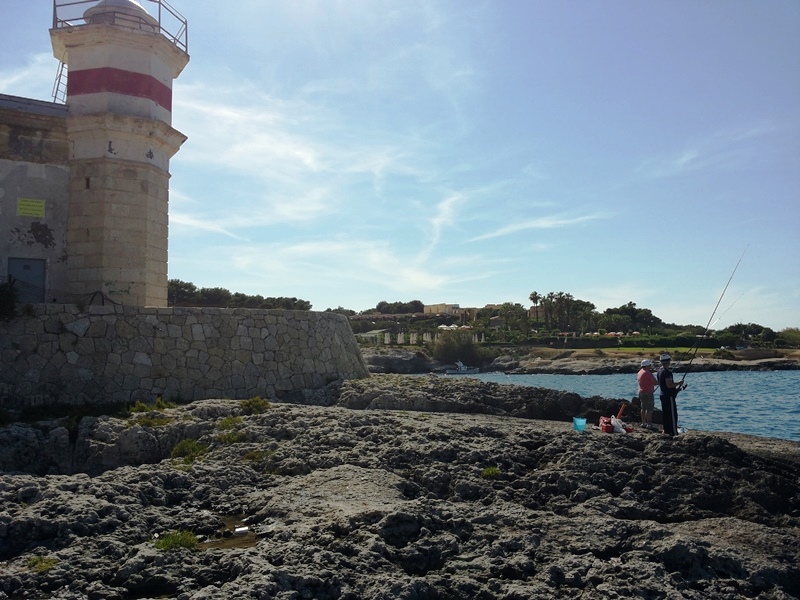Il castello di Brucoli, piccolo gioiello d’arte militare, fu voluto da re Giovanni II di Aragona quale dono alla regina Giovanna. Quest’ultima, nel 1468, affidò l’incarico di costruirlo a Giovanni Cabastida, Governatore Generale della Camera Reginale di Siracusa, un devoto ciambellano originario di Barcellona, che lo ebbe in concessione per tre generazioni.
L’Orsi, in uno dei suoi scritti, ci parla di un’epigrafe a caratteri bizantineggianti, posta sulla facciata meridionale del castello. Essa racconta delle fondazione del castello ed è curiosamente in prima persona, come se fosse lo stesso monumento a parlare:
“SOTTO IL REGNO DELLA REGINA GIOVANNA SONO STATA COSTRUITA PER CUSTODIRE LE MESSI DI BRUCOLI
SONO CHIAMATA TORRE CABASTIDA PERCHE’ GIOVANNI CABASTIDA MI FECE COSTRUIRE E DA LUI PRESI IL NOME”
La motivazione che spinse il lungimirante re Giovanni II di Aragona alla costruzione di una simile opera fortificata, era principalmente quella di premunirsi contro la preoccupante crescita della potenza turca. Nel secolo successivo all’edificazione del castello, alle incursioni dei Turchi si vennero ad aggiungere quelle barbaresche dalle coste settentrionali dell’Africa, cui tra l’altro è legata la leggenda del Santo Patrono.
Oltre che per scopi difensivi militareschi, la fortezza sorse all’imboccatura del porto-canale per controllare i commerci marittimi e custodirne le derrate di grano che vi confluivano. Dunque a protezione di quei traffici e del piccolo villaggio che sorgeva ai suoi piedi, il castello assumeva un ruolo di protezione fondamentale.
Secondo autorevoli studi, in origine, la struttura del castello constava della sola torre quadrata centrale, che ancora è visibile, ma che probabilmente svettava più alta e imponente dell’attuale. Successiva è la cortina muraria di difesa, di forma rettangolare, ai cui angoli sono quattro imponenti torrioni circolari. Tra le molte sovrapposizioni presenti nella struttura del castello, degne di menzione sono le due garitte, edificate probabilmente nel XVII sec.
Al suo interno erano diversi locali, quali la dimora del castellano, la foresteria, la cappella, l’armeria, le cucine, le scuderie e le carceri.
The castle Brucoli small jewel of military art, was commissioned by King John II of Aragon as a gift to Queen Juana. The latter, in 1468, entrusted the task of building it to John Cabastida, Governor General of the Chamber Reginale of Syracuse, a devoted chamberlain native of Barcelona, which had the concession for three generations.
The Bears, in one of his writings, talks about characters inscription in the Byzantine style, located on the southern facade of the castle. It tells of the foundation of the castle and it is curiously in the first person, as if it were the same monument to speak:
"UNDER THE KINGDOM OF REGINA GIOVANNA HAVE BEEN BUILT TO KEEP THE SET OF BRUCOLI
WHY ARE CALLED TOWER CABASTIDA 'JOHN CABASTIDA MADE ME BUILDING AND TAKEN FROM HIM THE NAME "
The motivation that drove the forward-looking King John II of Aragon to the construction of such a fortification, it was mainly to guard against the alarming growth of Turkish power. In the following century the building of the castle, the incursions of the Turks were to add those barbarian from the northern coast of Africa, which among other things is linked to the legend of the patron saint.
In addition to defensive purposes militaristic, the fortress was built at the mouth of the port-channel to control the maritime trade it and keeping the food grain that flowed there. So to protect those trades and the small village that rose to his feet, the castle took on a role of fundamental protection.
According to authoritative studies, originally, the structure of the castle consisted of one central square tower, which is still visible, but that's probably soared higher and more imposing of the current. Next is the curtain wall of defense, of rectangular shape, the corners of which are four massive round towers. Among the many overlaps in the structure of the castle, worthy of mention are the two watch towers, probably built in the seventeenth century.
Inside were several clubs, such as the residence of the lord, the guesthouse, chapel, armory, kitchens, stables and prisons.


